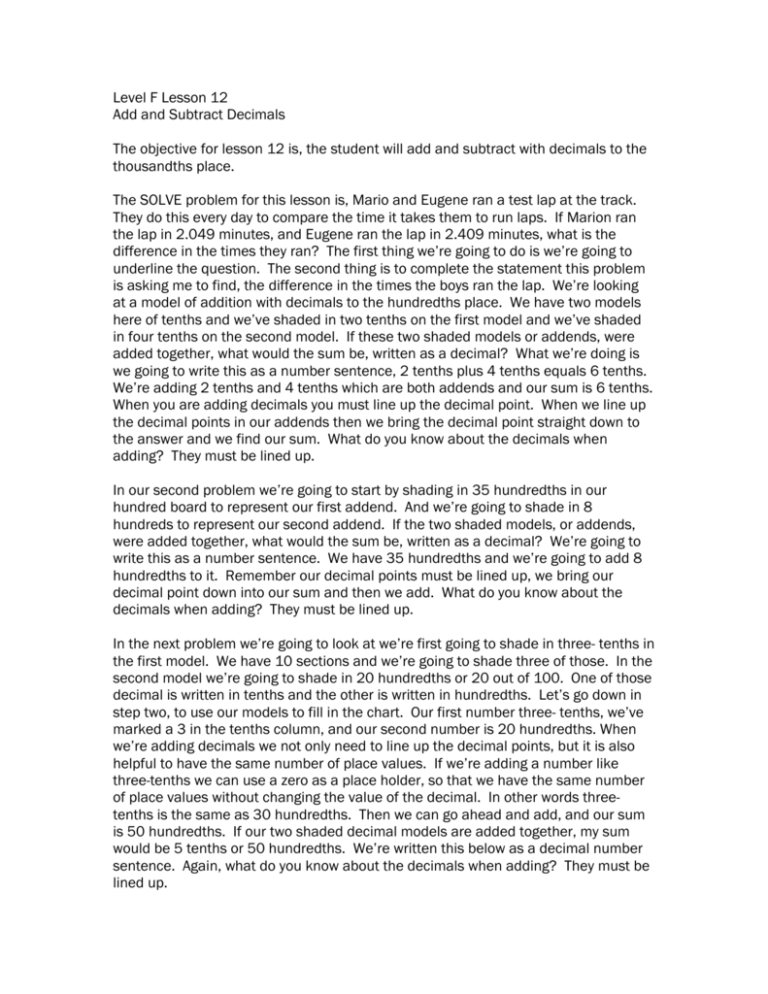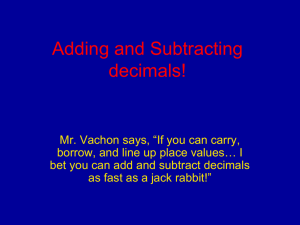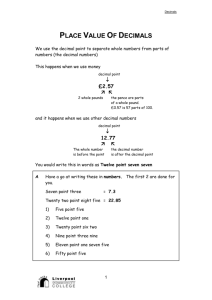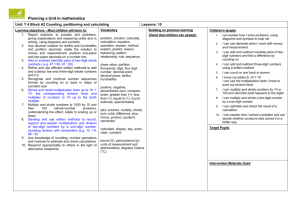LEVEL F LESSON 12 – ADD AND SUBTRACT DECIMALS
advertisement

Level F Lesson 12 Add and Subtract Decimals The objective for lesson 12 is, the student will add and subtract with decimals to the thousandths place. The SOLVE problem for this lesson is, Mario and Eugene ran a test lap at the track. They do this every day to compare the time it takes them to run laps. If Marion ran the lap in 2.049 minutes, and Eugene ran the lap in 2.409 minutes, what is the difference in the times they ran? The first thing we’re going to do is we’re going to underline the question. The second thing is to complete the statement this problem is asking me to find, the difference in the times the boys ran the lap. We’re looking at a model of addition with decimals to the hundredths place. We have two models here of tenths and we’ve shaded in two tenths on the first model and we’ve shaded in four tenths on the second model. If these two shaded models or addends, were added together, what would the sum be, written as a decimal? What we’re doing is we going to write this as a number sentence, 2 tenths plus 4 tenths equals 6 tenths. We’re adding 2 tenths and 4 tenths which are both addends and our sum is 6 tenths. When you are adding decimals you must line up the decimal point. When we line up the decimal points in our addends then we bring the decimal point straight down to the answer and we find our sum. What do you know about the decimals when adding? They must be lined up. In our second problem we’re going to start by shading in 35 hundredths in our hundred board to represent our first addend. And we’re going to shade in 8 hundreds to represent our second addend. If the two shaded models, or addends, were added together, what would the sum be, written as a decimal? We’re going to write this as a number sentence. We have 35 hundredths and we’re going to add 8 hundredths to it. Remember our decimal points must be lined up, we bring our decimal point down into our sum and then we add. What do you know about the decimals when adding? They must be lined up. In the next problem we’re going to look at we’re first going to shade in three- tenths in the first model. We have 10 sections and we’re going to shade three of those. In the second model we’re going to shade in 20 hundredths or 20 out of 100. One of those decimal is written in tenths and the other is written in hundredths. Let’s go down in step two, to use our models to fill in the chart. Our first number three- tenths, we’ve marked a 3 in the tenths column, and our second number is 20 hundredths. When we’re adding decimals we not only need to line up the decimal points, but it is also helpful to have the same number of place values. If we’re adding a number like three-tenths we can use a zero as a place holder, so that we have the same number of place values without changing the value of the decimal. In other words threetenths is the same as 30 hundredths. Then we can go ahead and add, and our sum is 50 hundredths. If our two shaded decimal models are added together, my sum would be 5 tenths or 50 hundredths. We’re written this below as a decimal number sentence. Again, what do you know about the decimals when adding? They must be lined up. We’re now going to look at a model where we’re going to use a whole number as well as fractions. In our place value chart here we’ve modeled the addition of these two models. The first model is we have a whole, one whole filled in, and the second part of that model is divided into tenths, so there are four- tenths, one and four- tenths. The second model we have one whole filled in, but our second model is divided into hundredths and if we count those we have 25 hundredths. In order to have the same number of place values we can use zero as a place holder. Because 1 and four- tenths is equivalent so we’re going to place the zero as a place holder. We’re going to bring our decimal point straight down and we’re going to add. And our sum is 2 and 65 hundredths. In your third column you’re going to write that, 1 and 40 hundredths plus 1 and 25 hundredths equals 2 and 65 hundredths. This is good practice for you to line up the decimal points because when you’re adding you must line up the decimal points, bring it down to the sum and then add. In our next model we’re going to be adding decimals to the thousandths place. Our two addends are 51 hundredths and 236 thousandths. Remember we want to have the same number of place values when were adding our decimals so we can add a zero as our place holder to the end of our 51. Because 51 hundredths is equivalent to 510 thousandths. Our second addend 236 thousandths, we have zero ones 2 tens, 3 hundredths, and 6 thousandths. When we add these two addends we’re going to bring down our decimal point and then we’re going add, 0 plus 6, 1 plus 3, 5 plus 2 is 7 and there are no ones. So our sum is 746 thousandths. In the last column on your paper you’re going to write that problem writing the two addends and the sum. Remember you need to line up your decimal points, bring it down to the sum and then add. We’re now going to be subtracting with decimals. When we subtract we’re going to model the first number. We’re going to start by shading in 9 out of the ten sections or 9 tenths in the model. We’re then going to cross out 3 of those to represent subtracting them. And our question is, how many shaded tenths are left? And the answer is 6. So what we’re going to do is we’re going to write what you did as a subtraction problem. We have 0.9 or 9 tenths and we’re going to take away or subtract 3 of those tenths. We have a difference of 6 tenths. The question is what do you know about decimals when subtracting? We have to line up the decimal points. Let’s look at problem three. We’re going to begin by shading in 56 hundredths in our model. So we have 5 full rows and then we have 6 hundredths in the sixth row we have a total of 56 hundredths shaded. We’re going to start by crossing out 30 of those hundredths, which is 3 complete rows. And we’re representing subtraction by crossing that out. How many shaded hundredths are left if we cross out or subtract those 30? And the answer is 26. We are going to move down here and write what we did as a subtraction problem. We have 56 hundredths and we’re subtracting 30 hundredths. We have a difference of 26 hundredths. What do you know about decimals when subtracting? You must line up the decimal point. We’re now going to be subtracting decimals with whole numbers parts. Our first model represents 1 and 5 tenths with shading. We’re now going to cross out 1 and 2 tenths. Of those how many shaded tenths are left? 3 We’re now going to write what we did as a subtraction problem. 1 and 5 tenths and we subtracted 1 and 2 tenths. We bring the decimal point down and we subtract and our difference is 3 tenths. What do you know about decimals when subtracting? They have to line up. The last problem we’re going to look at is 29 thousandths minus 1 hundredths. We have three place values to the right in our minuend but we only have two place values to the right of the decimal point in our subtrahend. We can rewrite that vertically, we have 29 thousandths, in order to line up our decimal points we’re going to have to add a 0 as a place holder in our 1 tenths. That is now 10 hundredths which is equivalent to 1 tenth. Remember the decimal points must always be lined up when adding and subtracting. We bring down our decimal point and the difference and we subtract 9 minus 0 is 9, 2 minus 1 is 1, 0 minus 0 is 0, 0 minus 0 is 0. Our answer is 19 thousandths. We’re now going to create a foldable for our decimals. We’re going to start by folding our paper in half, which is a hamburger fold, and then we’re going to fold it again, hamburger fold and we’re going to crease it. We’re now going to open it up so that we have 4 sections. Those sections are going to be adding decimals, subtracting decimals, multiplying decimals, and dividing. We have the problem 19 and 2 tenths plus 1 and 403 thousandths. We have the addend and the addend and our answer is the sum. For step 1, we want to line up the decimals vertically. We’re going to add zeros in empty places. Step 2, we’re going to bring our decimal point straight down to the answer. And step 3, we add. In the section of your decimal foldable called subtracting decimals you’re going to want to include the following information. You’re going to write the problem 18 and 3 tenths minus 1 and 42 hundredths. We’re going to write the names of the terms in a subtraction problem, minuend, subtrahend and difference. Step 1 we’re going to line up decimal points vertically, and we’re going to add zeros in the empty places. Step 2, we’re going to bring down the decimal point into your answer. Step 3, we subtract. We’re going back to the SOLVE problem from the beginning of our lesson. Mario and Eugene ran a test lap at the track. They do this every day to compare the time it takes them to run laps. If Mario ran the lap in 2.049 minutes, and Eugene ran the lap in 2.409 minutes, what is the difference in the time they ran? We’ve already underlined the question and we’ve completed the S step with the problem is asking me to find the difference in the times the boys ran the lap. In the O step we are going to start by identifying the facts. Marion and Eugene ran a test lap at the tract. That’s a fact. They do this every day to compare the time it takes them to run laps, fact. If Mario ran the lap in 2.049 minutes, and if Eugene ran the lap in 2.409 minutes, what is the difference in the times they ran? We’re now going to eliminate the unnecessary facts. We don’t need to know that they ran the test lap at the tract. We also do not need to know that they do it every day. The necessary facts are that Mario’s time is 2 and 049 thousandths minutes and Eugene’s time is 2 and 409 thousandths minutes. In the L step we’re going to choose an operation or operations. Since we see the word difference in our word problem we’re going to subtract. The next part will be to write in words what your plan of action will be. Subtract Mario’s time from Eugene’s time. The next thing we’re going to do is estimate your answer. The estimate here is about 4 tenths of a minute. The last thing we do in V is carry out our plan. We subtract our decimals 2 and 409 thousandths minus 2 and 49 thousandths for a difference of 36 hundredths minutes. In the E step we ask ourselves, does your answer make sense? We compare that to the question. Our answer is 36 hundredths minutes, and our question was what is the difference in the time. So, yes it does make sense because we are looking for the difference of time. Is your answer reasonable? We’re going to compare our answer to the estimate, and yes, our answer is reasonable because it is close to our estimate of 4 tenths of a minute. Is your answer accurate? This is where we’re going to check our work. We’re going to go back and subtract our 2 decimals. Remember we need to line up our decimal point and then we’re going to subtract. Our answer is correct. The last thing we’re going to do is to write our answer in a complete sentence. The difference in the time Mario and Eugene ranthe laps is 36 hundredths minutes. Now we’re going to go back and answer the essential questions from the beginning of our lesson. The first question is, why is it important to know how to add decimals? The answers may vary in your class, but one of the possibilities is when adding money. Why is it important to know how to subtract decimals? Again, the answers in your classroom may vary, but subtracting money would be an appropriate answer. How can you add and subtract decimals with different place values? You can use 0 as a place holder, so the decimals have the same number of place values.









